Before you start reading the interview, let me say I am a big fan of Art Wolf and I am very glad that I got the chance to publish his interview.
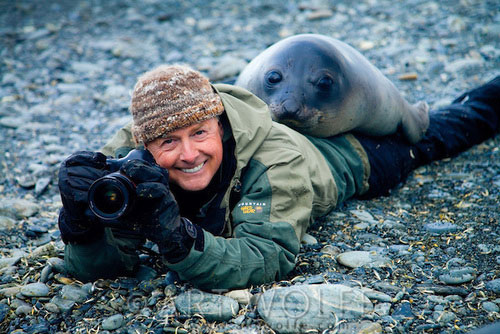
How do you keep yourself motivated and your photography fresh?
I photograph without prejudice, just about anything can be a subject for me thus when I’m in the field looking for Snow Leopards I am just as happy to be finding wonderful abstracts in the rocks, scenic landscapes and cultural and religious shots in the local villages. I generally have 2 dozen different projects in my head at a single time, books I’m thinking of, presentations, new angles to teach from and I’ll photograph where ever I am in the world finding subjects that will work with a variety of projects. I’ll also challenge myself to return to old subjects that I’ve shot many times before and look at them with fresh eyes – I’ll try and find new ways to photograph them with the equipment available today. Years ago ISO 100 was “fast film”, ISO 400 was often too fast for my work even… Today where the circumstances dictate I’ll shoot at ISO 1600 and have no problem going up to 6400 and even beyond on occasion. This has opened up whole new worlds of photography for me that were previously untouchable – such as hand holding a 400mm lens while sitting in a small boat going down a river photographing Jaguars in the underbrush who are hunting for monkeys. Or photographing macaws in flight where you have less than a second to see the bird, focus on it and get the shot before it’s out of view again and back in the trees – these shots just weren’t possible 10 years ago.
I constantly evaluate my own work and I am always learning, always improving. What I do is create art, I’m not just trying to record the world exactly as my eyes saw it, I’m trying to create art and thus I can return to past subjects and discover new ones all the time with fresh perspectives.
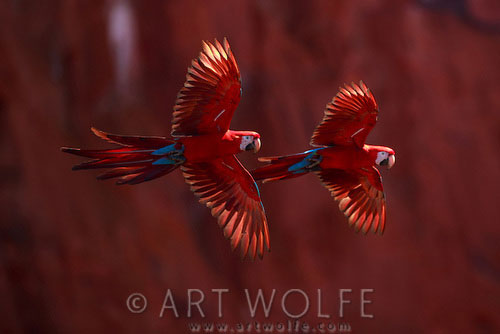
What advice do you have for photographers just starting out?
If you have a passion for photography, follow that passion, just don’t try and turn it into your sole living and pay all of your bills with photography from the start. That is a very difficult path and one that has burned out many a passionate artist far too soon. Most of the people I find coming to my seminars and workshops are professionals who have followed a traditional career path and they are looking to exercise their creative and artistic sides. Find a balance in your life, one that allows you to fuel your passion without putting so much stress on you that it becomes a burden and a “job” that eventually burns out.
As you start to acquire the tools of your trade invest in the best quality lenses you can buy and a slightly lesser quality camera back than you can afford. Quality glass will last you years, a decade even before you want to upgrade – where as the camera you buy today will be obsolete in a year or two as they come out with better and improved models all the time. At this time I still shoot with a traditional Canon DLSR but don’t overlook the mirrorless systems, as they improve the lenses that are offered in these systems you’ll see more professionals turning to them in the future. These days, at over 60 years old, I’m all about smaller and lighter if the quality is there.
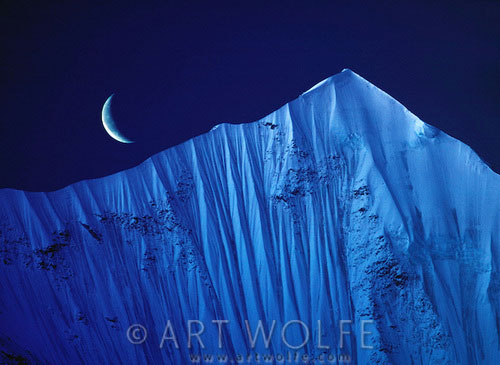
Did you go to school to study photography?
This goes to the previous question as well – what advice I have for those starting out: I did not go to school for photography, rather I studied fine art in college (University of Washington). I was a fine art painter long before I was a photographer and that has provided me with the best foundation a photographer could ever ask for studying art history and art appreciation. Learn what it is about the masters paintings that have allowed them to endure for centuries while their colleagues have been long forgotten. Take drawing classes, sculpture, get introductions to a variety of different art mediums. The lessons you learn there all directly apply to fine art photography. I’m not talking about photo journalism, I’m talking about using the camera and lens, the shutter speed and aperture, to compose an image making deliberate decisions as to what you include in the frame, where you set your focus, looking at positive and negative space, line and pattern just as any artist would with brush and canvas. Just pointing the camera in the same direction at the same time as a professional is not fine art photography, understanding why and what you are looking for in your composition is just the beginning.
As for my education with the camera – I was self taught largely because in those days there weren’t classes I could take from professionals like myself, they just didn’t exist and if they did, I wasn’t aware of them. It made for a much longer learning curve and a lot of over and underexposed slides along the way but slowly I learned the lessons many take for granted today.
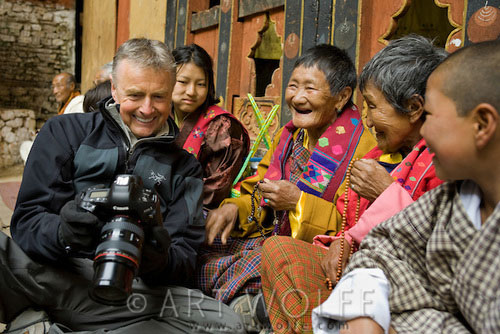
How long have you been a photographer?
I took my first wildlife photos of a moose using a Kodak Brownie camera while at a YMCA camp in Jr. High. From that day on I was hooked but it wasn’t really until I was in my young 20’s that I put down the paints and easel in favor of a camera full time. I illustrated my first book, “Indian Baskets of the Pacific Northwest and Alaska” in 1979, however it wasn’t until I joined the first US Everest expedition allowed in through Tibet in 1984 that I felt as though I had arrived, or put myself on the map, as a professional nature and landscape photographer. Over the years I have produced nearly 90 books and taught lectures and lead workshops around the world. I have always been an artist and passionate about conservation and preserving and improving this beautiful planet we all share and photography has allowed me to share that passion with others.
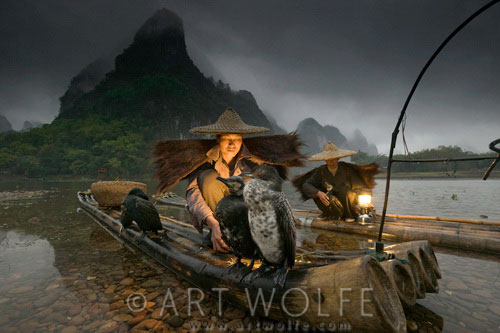
How would you describe your style?
My style has evolved over the years and continues to evolve as I grow as an artist, learn more, evaluate my work, try new techniques and new approaches and I suspect it will be forever evolving as long as I am alive. The roots of my style are firmly grounded in my experience as a painter with watercolors and oils and those fundamental courses I attended while in college. Initially my lens was turned towards wildlife, in the Pacific Northwest and then later the Western US and then the world as I began to travel to photograph more and more of the amazing species that share this earth. Initially I was photographing the classic trophy shot of an animal, a head hunter, tack sharp eyes, blurred background cropped at the shoulders. It wasn’t until I was sharing a raft on a river with a wildlife illustrator that I saw in his work that he would include not only the entire animal but sharp details that made up the surroundings and habitat. At that point I began to draw back and include more and more of the landscape to give the viewer a sense of place.
I was always trying to pull the animals forward in the frame, making them obvious and eye catching to the viewer, and for a change I challenged myself to do the exact opposite. To photograph the animal allowing it’s natural camouflage to hide them from the viewer. To let them recede in the frame and disappear from view. This became a whole new study and a 9 year effort that resulted in the book “Vanishing Act” which is being updated and republished in Oct 2014.
Later in my career I began photographing indigenous cultures around the world (many of which you can no longer find today without strong western influences) using a more cinematic approach, choosing to shoot with a wide angle lens, up close, allowing the subject to really dominate the composition while distorting the view to the background. I used this approach with wildlife as well resulting in the book “The Living Wild”.
Another style I have played with and enjoyed was one of emphasizing the movement and energy in a running animal, that was showcased in my book “Migrations”. This was partly a forced upon me by the equipment of the time, slow transparency film that simply did not allow for tack sharp images stopping the motion of a bear in a river, and lately I have been enjoying the opposite extreme using today’s digital cameras and extremely high ISOs to fully stop ever drop of water in the frame as a bear rushes a salmon in an Alaskan river.
So all of these have been my “style” over the years, I suppose the one common thread is that I am an artist, I am trying to create beautiful images, no just documenting the world as I saw it. I’ll use different lenses to compress or stretch a landscape, to change the relationship between a foreground subject and the background, I’ll use filters to darken a sky and balance the overall exposure in an image, I photograph as I would have painted the scene before me.
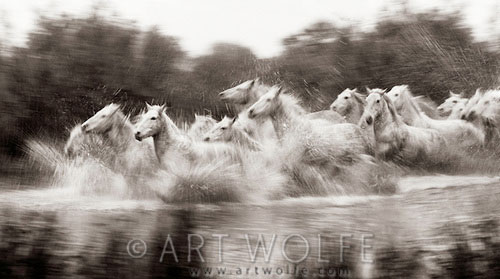
Who or what inspires you in your personal life and work?
In my personal life I am an avid gardener. Over the last 20+ years I have turned the landscape of my home in West Seattle into a Japanese style garden influenced by the magnificent views, rock towers and natural bonsai trees found in the Huang Shan Landscapes of China. My home is dedicated to my pursuits as an artist with a collection of art pieces that I have purchased as I have traveled the world over the last 40 years and my garden is where I return after every trip to unwind and ground myself.
In my work I would say I am most influenced by the classic painters such as Monet, Renoir and Escher as well as more contemporary artists such as Tobey, Wyeth and Pollack. I am constantly looking at the natural world around me looking for inspiration from their styles and how I might compose an image in a single frame of a camera that invokes their styles with brush and canvas. In my “Human Canvas” work I directly explored these influences as well as designs from tribal and indigenous art and they can easily be seen in the compositions I created as I painted models, covered them in clay, and intricate designs and then posed them over backdrops I had painted in advance visualizing the final composition for the shoot.
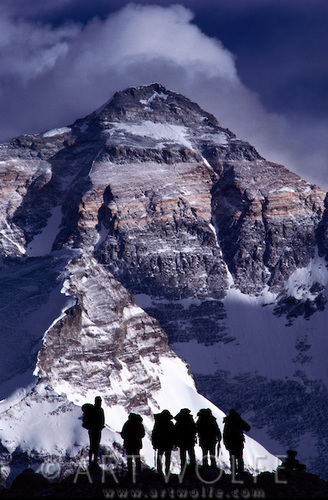
Tell us a little bit about Your Camera and Lenses?
I have shot with a variety of systems over the years, Nikon, Canon, Sony, Leica, PhaseONE etc. And they are all excellent systems. Use what you have, I won’t profess that one is so much better than another that you have to have it, they all have their strengths and weaknesses. As you begin to acquire lenses that will last you a decade or more you’ll find it gets very difficult to switch between brands.
Today I shoot with Canon equipment, a 1DX and 5DMIII are with me in my bag at all times. I have 2 favorite lenses that I have used for longer than I can begin to remember, a 16-35L and 70-200L f4 (lighter and just as sharp as the f2.8). Those are responsible for easily over 80% of the 1 million plus images in my archives. A couple years ago I picked up the 24-70 and I find it to be a good walking around lens when I find myself in a small village shooting markets and portraits. And most recently I picked up the new 200-400L for my big telephoto. It has a built in 1.4x, excellent quality and I can even put on a 2x bringing it up to 1120mm with acceptable results at far less weight than carrying a 500 or 800 mm lens as I had in the past.
Of equal importance is a good tripod and ball head. I like Gitzo tripods and use a Kirk head – it’s important that it is light enough that you won’t hesitate to take it with you and use it all the time. An excellent camera and lens combination can be rendered useless on a sloppy tripod or raised up on a center column (which is just a mono-pod balanced on a tripod at that point). Using a tripod does more than just stabilize your camera for a sharp image – it slows you down and forces you to scrutinize you composition more carefully. To think about your aperture and shutter speed choices. It gives you time to check all 4 corners of the frame and adjust or remove distractions.
Website www.artwolfe.com | Facebook






